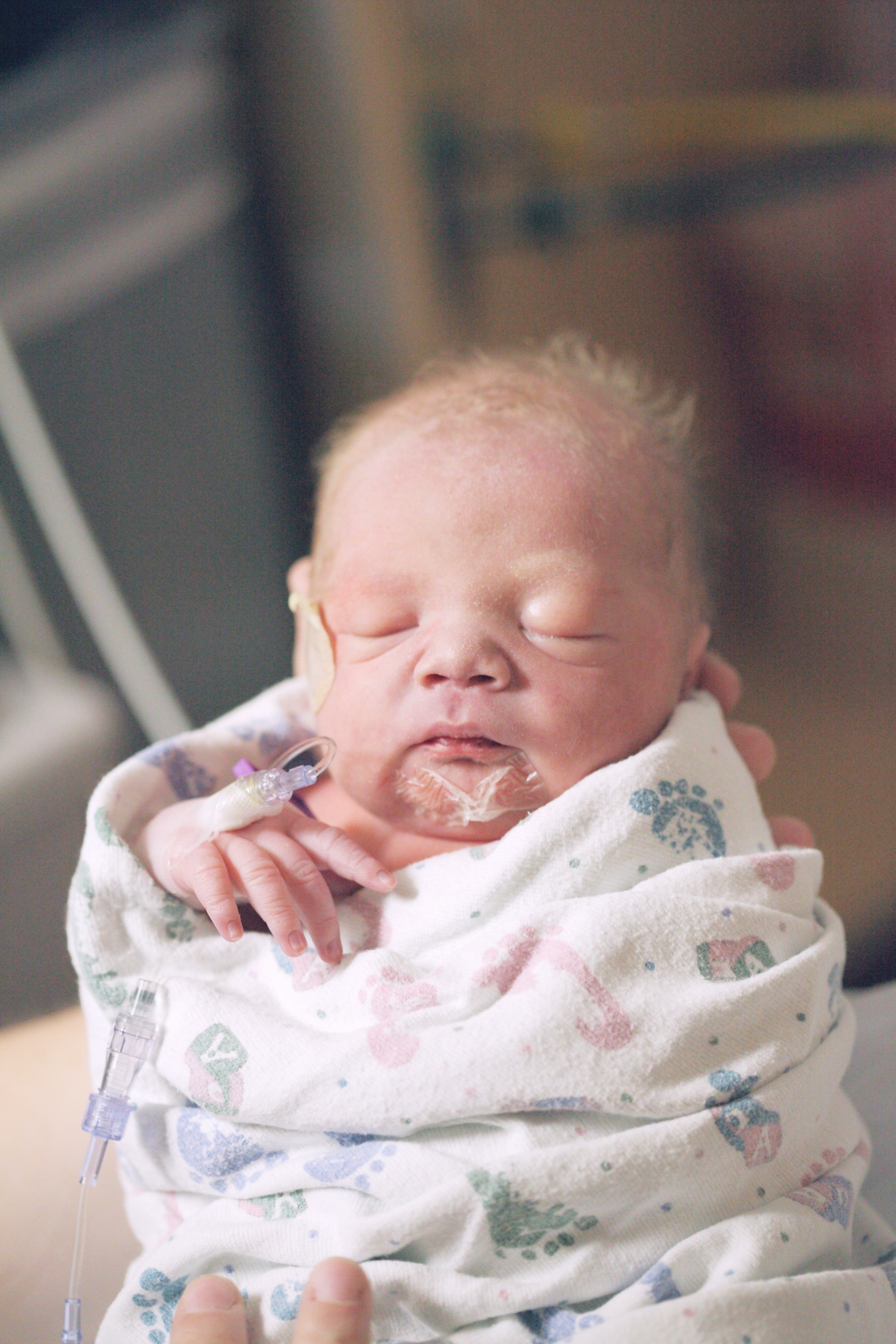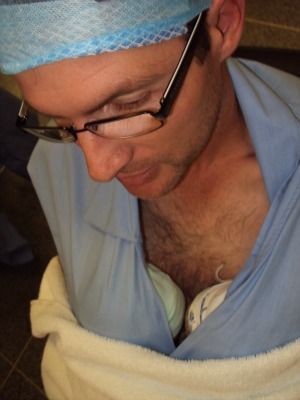(KMC) Kangaroo Mother Care Benefits and Guide
Your breasts will keep your baby at the ideal temperature for sleeping, breathing, and using the least amount of energy necessary so that your little one can instead focus on growing and thriving.

Page Quick Links
- How to practice KMC
- Types of KMC
- The advantages
- Breastfeeding and KMC
- The history of KMC
- Premature babies and KMC
- How does KMC reduce infections
- KMC care wards at hospitals
- KMC clothing and wraps
- KMC support for mother
- Going home
- Dads and KMC
Kangaroo Mother Care
Kangaroo Care, more accurately referred to as Kangaroo Mother Care (KMC), essentially involves:
- Skin-to-skin contact with a baby in an upright position between the mother's breasts.
- Exclusively breastfeeding and
- Supporting mother and baby as a pair.
You can start with kangaroo mother care right after giving birth or a few hours, days, or weeks later. It all depends on your unique situation.
Is it your preference? Is your baby premature or ill? These are some of the factors that will determine when you start with kangaroo mother care.

Wondering How To Do It?
- Your baby will only be wearing a nappy and, if needed, a beanie or hat. Some new studies recommend that mothers not use a beanie, as the smell of the baby's head plays a role in releasing hormones for bonding and breastfeeding. Yet others suggest that babies lose much of their body heat through their heads, making a hat essential. During the first few days after birth, it's important to establish breastfeeding, so keep the room comfortably warm and don't use a hat until then.
- You will wear a shirt that opens up in the front or maybe even go topless for the time you are doing this with your baby.
- Then you'll place your baby onto your naked chest (no bra) in an upright position. The upright position is considered best, as it helps the baby crawl and self-attach to the breast. Watch the breast crawl video here, where a baby independently crawls and attaches to the breast directly after birth.
- Next, you'll cover your baby and yourself with a sheet or blanket. You could use a light blanket or a special wrap/shirt specifically designed for kangaroo care. If the room is warm and you feel comfortable without a cover, go for it!
- Your baby's head should be slightly extended to the side so that their airway is open and you can have eye contact with your baby.
- Their legs should be in a froggy position, which is important for hip and joint development. It's also closer to the way they were lying inside the womb.
- Having their hands close to their face will allow them to self-soothe.

Types Of Kangaroo Mother Care
- Intermittent: This is when kangaroo care is done for periods of time.
If your baby is still nursed in an incubator because of needing monitoring, or if you have been released from the hospital and can not stay with your baby 24/7, you can do intermittent kangaroo mother care.
It is okay if it's just a matter of preference. The important thing to remember is that you need do this for at least one full sleep cycle to maximize the benefits.
- Continuous: This is when the baby stays on your chest day and night.
It could either be because there aren't any incubators available for your baby, or it could be your preference. This is the optimal option. If your doctor gives you the go-ahead, you and your baby will benefit most from continuous care, even more so if your baby is premature.
Up to what age should KMC be done?
This is up to your baby and yourself. As your baby grows and thrives, you can follow their cues and decrease the periods spent in the kangaroo position accordingly.
It will be a natural progression if you are in tune with your baby's needs, which is something you pick up when you spend so much time with your baby so close to you. And chances are, you will feel slightly disappointed once it's over.
The Advantages of Kangaroo Mother Care

Twin Fact: When mom holds both babies, each breast will regulate each baby according to their needs.
The most astounding fact is that the mother's breast temperature can rise and fall to warm or cool her baby down as needed.
Your breasts will keep your baby at the ideal temperature for sleeping, breathing, and using the least energy necessary so that your little one can instead focus on growing and thriving.
It has been proven that a mother can better control her baby's temperature than a servo-controlled incubator!
Then there's the movement of the mother's chest from her breathing. This stimulates the baby to keep breathing and keeps their heart rate stable. In fancier medical terms, it prevents and decreases Apnea and Bradycardia. (Apnea ~ when baby stops breathing. Bradycardia ~ when the baby's heart rate slows down)
This, in turn, keeps the baby's oxygen levels where they should be (Oxygen Saturation) and helps your baby sleep for more extended periods. And we've all learned that children grow when they are sleeping. If your baby is premature, very small, has low muscle tone, or didn't grow optimally in the womb, this is especially important for you.
And... medical interventions like drips, ventilation, monitors, and so on do not affect kangaroo care. The baby can still have all those gadgets attached while lying on your chest. Many have found that these things are not as needed when practicing KMC. So all the more reason to take advantage of kangaroo mother care.
If your baby needs to be transported to another hospital or clinic, you can use kangaroo care as a safe and effective means to keep your baby stable. And if you can not do it yourself, ambulance staff can keep your baby in the kangaroo position.

The Tushbaby Hip Carrier
With its ergonomic design and comfortable waistband, Tushbaby provides optimal support for you and your baby. Say goodbye to shoulder and back pain from traditional carriers, as Tushbaby evenly distributes your baby's weight, relieving strain and promoting better posture.
Breastfeeding and Kangaroo Mother Care
Marsupials like kangaroos carry their babies in their pouches, giving them full access to their source of nourishment. The word mother was added to the term to emphasize the importance of the mother and her breast milk.
Exclusively breastfeeding your baby on demand is ideal. Whether your baby breastfeeds directly from your breast or gets your breastmilk via a nasogastric tube (the little tube that goes through the nose into the tummy), a cup or other method is not the point. The point is that your baby should get YOUR milk, which is specifically designed for YOUR baby, at that stage.
Skin-to-skin contact helps establish breastfeeding, so don't feel discouraged if your baby can't suck on your breast immediately. The fact that they are close to their source of nourishment and are stimulated by the smell of your milk and skin will help towards breastfeeding successfully, eventually.
The History of Kangaroo Care
In 1978 Dr. Edgar Rey Sanabria, in Bogota, Colombia, began the practice of Kangaroo Care out of necessity. There weren’t enough resources and incubators to care for all the premature babies in the hospital, making the death rate very high. Since then, studies have been done on this practice, and they found a decrease in the number of babies dying with the introduction of KMC. Not only were more babies surviving, but they were even thriving!
It has become more than just an alternative to incubator care.
Premature and Low Birth Weight Babies
Just because your baby was born too soon doesn't mean you can't continue the gestation period.
KMC provides the perfect opportunity for you to help your baby grow, in an environment similar to the womb, until they are full term. Think of it as a womb with a view.
Many mothers of premature babies and low birth weight babies end up feeling anxious because they have to watch the medical staff care for their babies and don't get to do much for them. It is stressful and exhausting. But with kangaroo mother care, the mother does most of the caring. This builds her self-confidence and reduces anxiety. It empowers her to step into the role she looked forward to during her pregnancy. She can be a mother in the complete sense without having to wait until her baby is 'strong' or 'big' enough.
Not only that, research shows over and over again that babies who receive KMC thrive far better than those who are given traditional medical incubator care. The smaller the baby, the more vital kangaroo care becomes.
How Does It Reduce Infections?
When your baby is placed on your skin, they become colonized with your bacteria. This causes your body to produce antibodies in response, specifically protective against harmful bacteria.
When your baby is placed in an incubator, they become colonized with hospital bacteria, which might infect the baby. We've all heard how hospital bacteria tend to become resistant to many antibiotics... It's not good.
This is especially not good in poor countries with limited resources. And where incubators are not always in optimal working condition, adequately cleaned, or have reliable power supplies. That is, if they even have money for an incubator.
Kangaroo care can overcome all these obstacles by providing babies with the perfect immunity and nutrition, the perfect temperature regulation, and safety.
Kangaroo Mother Care Wards
Some hospitals/clinics have special wards where mothers and babies can practice kangaroo mother care while the nursing staff supervises them.
This allows mothers to take on the responsibility of caring for their own babies and lightens the nursing personnel's load. Everybody wins!
Another benefit of KMC wards is that mothers support and encourage each other. They are going through similar experiences, and being able to talk to someone who's been there and done that is invaluable.
Clothing and Wraps
Any shirt or dress that opens up in front will do for the mother. There are a few items of clothing specially designed for this purpose that you may wish to purchase.
Support for Mom
This goes beyond just having emotional support. It involves physical and educational support as well.
- First, the mom needs to understand the whole process of kangaroo mother care. She needs to know the benefits and why it is essential for her and her baby. This should ideally be incorporated in antenatal care while she is still pregnant, so she can do more research and prepare herself for it once her baby is born.
- Second, she needs lots and lots of emotional support and encouragement from her family and the nursing and medical staff. Providing this kind of care to a baby is a huge commitment, even though it is well worth it.
- Third, she needs physical support. This could either mean dad and other family members or friends help or at least lighten the burden of household chores. They can also take over kangaroo care for short periods.
Finally... Going Home
Once your baby is healthy, gaining weight (at least 20g per day), can breastfeed or cup feed well, and you are confident to manage your baby on your own, you can finally go home.
Usually, you will leave the hospital with your baby in the kangaroo position and continue the practice at home for as long as you and your baby desire.
For premature and low birth weight babies, this may mean that you can join your family sooner than with traditional medical care.
Be sure to have regular follow-up visits with your healthcare professional to ensure that your baby is gaining weight, growing, and thriving as expected.
Dad & Kangaroo care

This will significantly help the mother, especially after a cesarean section or when she has multiple babies (twins, triplets, or more), strengthening the family bond.
Also, dads who spend time skin-to-skin with their babies are less likely to abuse their children or become violent towards them. This is what studies are showing.
It's a great way to bond with your baby!
Kangaroo Care Benefits
Kangaroo Mother Care Benefits for Baby
- Baby's breathing is regular, and there is a reduced chance of apnea.
- A stable heart rate. The movement of the mother's chest as she breathes stimulates her baby to keep breathing normally.
- It could also reduce the risk of SIDS (sudden infant death syndrome), also known as cot death.
- The baby has better oxygen levels.
- Better blood sugar levels.
- The baby has long, deep stretches of sleep.
- When they are awake, they are more alert.
- They gain weight better and faster because they don't have to use their energy to try to keep warm.
- They also have better control of body temperature.
- It has been proven that a mother can control her baby's temperature better than a servo-controlled incubator. Which leads to lower chances of cold stress (hypothermia)
- These babies cry significantly less and have much lower stress levels.
- There is less chance of infection. This is by far one of the main kangaroo care benefits in both poor and wealthy countries alike.
- Motor and brain development is positively affected because these babies have more energy to use for developing and growing.
- They have a higher pain threshold than babies who do not receive kangaroo care.
- It is a safe and convenient way of transporting your baby between hospitals and clinics, especially when there are no transporting incubators available.
- The baby is sent home earlier than if they had received standard care, as kangaroo mother care can be continued at home.
Kangaroo Care Benefits for Parents
- Kangaroo mother care creates a sense of competence and confidence in the mother. She feels like she can do something for her baby, especially when the baby is tiny, premature, or ill.
- Mom also gets the feeling that she is completing the gestation period. Dr. Ashley Montagu calls this the exterogestation period or external gestation period. Kangaroo care is the closest recreation of the womb.
- If the birth was traumatic and the mother and her baby had to be separated, kangaroo mother care can help restore their bond.
- Decreases the occurrence of postnatal depression in the mother.
- Violence, abuse, and abandonment rates decreased.
Kangaroo Care Benefits Related to Breastfeeding
- Skin-to-skin contact promotes the release of oxytocin. This hormone has a calming effect on the mother and her baby and regulates milk production. Mothers who practice kangaroo care are more likely to have a good milk supply.
- The mother's milk adjusts to her baby's nutritional and immunological needs, hence the term 'designer milk'.
- The chances of successfully breastfeeding and continuing to breastfeed for longer are much higher when KMC is practiced.
- Babies as premature as 30 weeks can begin breastfeeding when receiving kangaroo mother care. But alternative feeding methods exist for those unable to suck directly on the breast.
- The mother and baby's sleep cycles synchronize, which means they will sleep and wake together, helping both get the rest they need.
- The mother's uterus contracts and returns to its average size sooner, which also helps limit her blood loss.
Other Kangaroo Care Benefits
- Where there are Kangaroo Mother Care Wards available, mothers have the benefit of learning from and supporting each other.
- Morbidity and mortality rates are lower, as babies are more likely to survive. Even tiny babies who were not considered viable have beaten the odds and survived due to kangaroo care.
- For hospitals, the benefits are reduced costs. Less expensive technology and fewer staff members are needed. Other hospital costs are also reduced.
- Because fewer babies get infections, the need for intensive or special care also decreases.
Dr. Susan Ludington sums up Kangaroo Mother Care by saying:
"Separation is not biologically normal."
